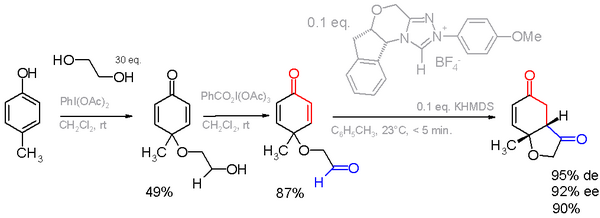User:Edamato/sandbox
The Stetter reaction is an organic reaction involving the nucleophile catalyzed conjugate addition of an aldehyde to a Michael acceptor such as an enone.[1] The reaction product is a 1,4-dicarbonyl compound. The active catalyst can be a combination of a thiazolium salt and a base (which forms an N-heterocyclic carbene in situ) or cyanide anion. It was found by Dr. Hermann Stetter in 1976.[2]

Reaction mechanism
[edit]Key in the reaction mechanism is the conversion of the aldehyde carbonyl group from an electrophile to a nucleophile in an umpolung process. This is accomplished by deprotonation of the quaternary thiazolium salt 1 by base to the thiazolium ylide 2 which reacts in a nucleophilic addition with the aldehyde 3 to the tetrahedral intermediate 4. After a 1,2-rearrangement reaction of the methylene proton in 4 to oxygen the resulting carbanion 5 is able to react with enone 6 in a Michael reaction to adduct 7. A hydrogen migration takes place to 8 after which the thiazolium group is expelled generating the 1,4-diketone 9 and completing the catalytic cycle.

The Stetter reaction is related to the Benzoin condensation where the nucleophilic catalyst is a cyanide ion and the electrophile a carbonyl.
Scope
[edit]The Stetter reaction produces classically difficult to access 1,4-dicarbonyl compounds and related derivatives, such as 1,4-ketoesters and ketonitriles. Intramolecular aldol-type cyclizations of these products leads efficiently to cyclopentenones and related compounds.[3] An example of the Stetter reaction is the preparation of 2,5-undecanedione from heptanal and 3-buten-2-one as shown below.[4]

Just as with benzoin condensations the reaction can be carried out as an intramolecular asymmetric synthesis using persistent carbenic triazolium salts, exemplified by the synthesis of a hydrobenzofuranone shown below.[5] The base in this reaction is KHMDS.[6]

Variations
[edit]Several variations of the Stetter reaction have been developed since its discovery in 1973.
Asymmetric
[edit]The first asymmetric variant of the Stetter reaction was reported in 1996 by Enders et al, employing a chiral triazolium catalyst.[7] Subsequently, Rovis and coworkers developed a family of related chiral triazolium catalysts that generated intramolecular Stetter products in high enantiomeric excess (82-97% ee).[8]
Related
[edit]References
[edit]- ^ Review. Catalyzed Addition of Aldehydes to Activated Double Bonds - A New Synthetic Approach Stetter, H. Angewandte Chemie International Edition Volume 15, Issue 11, Pages 639 - 647 1976 Abstract
- ^ http://careerchem.com/NAMED/Named-Rxns(Q-T).pdf
- ^ Stetter, H.; Kuhlmann, H. Org. React. 1991, 40, 407. doi:10.1002/0471264180.or040.04
- ^ H. Stetter, H. Kuhlmann, and W. Haese Organic Syntheses, Coll. Vol. 8, p. 620; Vol. 65, p. 26 Article
- ^ Asymmetric Synthesis of Hydrobenzofuranones via Desymmetrization of Cyclohexadienones Using the Intramolecular Stetter ReactionQin Liu and Tomislav Rovis J. Am. Chem. Soc.; 2006; 128(8) pp 2552 – 2553; Abstract
- ^ The first step in this sequence is the oxidation of p-cresol by iodosobenzene diacetate in presence of 30 equivalents of ethylene glycol, the second step another oxidation this time of the hydroxyl group by Dess-Martin periodinane.
- ^ Enders, D.; Breuer K.; Runsink, J.; Teles, J. H. Helv. Chim. Acta 1996, 79, 1899.
- ^ Kerr, M. S.; de Alaniz, J. R.; Rovis, T. J. Am. Chem. Soc. 2002, 124, 10298.
Category:Addition reactions
Category:Carbon-carbon bond forming reactions
Category:Name reactions

